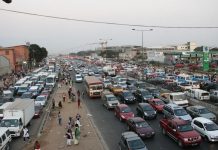Africa-Press – Angola. The Angolan capital (Luanda) continues to be the most populous province in the country, with 24.1% (8,816,297 inhabitants) of the 36,604,681 people who live in Angola, according to the final results of the General Population and Housing Census (RGPH) 2024, released Thursday (18) by the National Statistics Institute (INE).
Next are the provinces of Huíla, with 9.0% (3,302,866), Huambo, with 7.4% (2,691,902) and Benguela, with 7.1% (2,597,638), while Cuando is the least populous province in the country, with 138,770 inhabitants.
Among the three new provinces created this year within the framework of Angola’s Politico-Administrative Division (DPA), Icolo e Bengo leads with 1,372,670 people, while Cubango has 570,447 and Moxico Leste has 411,074 of the total population.
The country’s average population density is 29 inhabitants per square kilometer, with significant differences between municipalities located in provincial capitals and on the coast.
Another noteworthy point from the 2024 Census is that approximately 24% of the Angolan population resides in the ten most populous municipalities in the country, such as Kilamba Kiaxi, Cacuaco, Lubango, Viana, Huambo, Cazenga, Maianga, and Camama, which cover an area of less than 1% of the national territory.
Regarding the release of the final results of the General Population and Housing Census, the Director-General of the INE (National Statistics Institute), Joel Futi, assured that the figures presented are supported by a rigorous and internationally validated statistical methodology.
In statements to the press, the official explained that the INE applied the dual-system estimation method, combining data collected in the field with information from the coverage survey, which allowed for the identification of omissions and the correction of duplications.
He emphasized that this process guarantees the completeness and reliability of the total population.
“The data result from a technically robust process, fully aligned with international standards, and all omissions have been adjusted, with the final result accurately representing the demographic reality of the country,” he stated.
He mentioned that the Census counted nine million households, a number equivalent to the total number of registered dwellings.
He also added that the population remains young, with an average age of 23 years, although a slight reduction was observed in the 0-to-nine-year-old age groups.
The presentation of the final results of the 2024 Census comes ten months after the end of the mass data collection and six months after the completion of the Coverage Survey.
The final results are derived from counting the resident population in the country, with reference to September 19, 2024, when the census began and ended on November 19 of the same year.
Data Collection Methodology
The 2024 Census is the second conducted after National Independence and the first operation carried out digitally, with interviews supported by the CAPI (Computer Assisted Personal Interview1) technological platform and complemented by CATI (Computer Assisted Telephonic Interview2) during control visits.
The preparatory organization of this operation was based on the international principles and recommendations contained in the United Nations’ “Handbook on the Management of Population and Housing Censuses, Revision 3,” widely used by national official institutions in the planning and execution of Population and Housing Census operations.
The 2024 RGPH also distinguished itself through technological innovation in all census phases, namely cartographic updating, data collection and processing, which ensured greater speed in obtaining the final results and their dissemination.
The use of Geographic Information Systems (GIS) for updating the country’s cartographic grid, within the scope of conducting the General Population and Housing Census The 2024 census was a fundamental step forward, as the creation of the georeferenced database of households and other national reference structures marks the beginning of a new phase of technological innovation in censuses in Angola, and a new era for the National Statistical System (SEN) and, in particular, for the National Institute of Statistics (INE).
This operation comes ten years after Angola conducted the 2014 Census, which took place from May 16 to 31. At the time, the Angolan population was estimated at 25,789,024 inhabitants, of which 6,945,386 lived in Luanda, the most populous province in Angola.
Of the 2014 census population, 12,499,041 were men and 13,289,983 were women.
The Census serves as a mechanism for a country to assess its population and housing numbers each year. 10 years, constituting a rich source of data on the demographic, socioeconomic and geographic characteristics of the population, as well as the characteristics of dwellings, over a given period of time.
For More News And Analysis About Angola Follow Africa-Press






